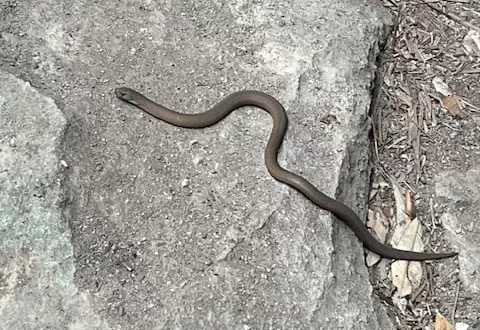
Australia is home to some of the most fascinating and dangerous wildlife, and the Eastern Brown Snake is a prime example. I recently came across what I believe was a juvenile Eastern Brown Snake on a recent hike, which prompted me to research and write about them. As one of the most venomous snakes in the world, it commands respect from hikers venturing into its territory. In this guide, I will explore everything you need to know about the Eastern Brown Snake and how to stay safe on your hiking adventures.
About the Eastern Brown Snake
The Eastern Brown Snake (Pseudonaja textilis) is widely regarded as one of the most dangerous snakes in Australia due to its potent venom.
- Appearance: These snakes are typically brown in color, ranging from light tan to dark brown, with a slender body. Juveniles may display bands or a black head.
- Size: Adults can grow up to 2 meters long, although most are smaller.
- Habitat: Commonly found in eastern and southern Australia, the Eastern Brown Snake thrives in grasslands, farmland, and even suburban areas.
- Fangs: The snakes have relatively small fangs, up to 3.5 mm, compared to other snakes.
Behavior and Risks
Despite their reputation, Eastern Brown Snakes are not inherently aggressive.
- Behavior: They are shy by nature and will typically flee when approached. However, they may defend themselves if threatened.
- Venom: Their venom contains neurotoxins and coagulants, making bites potentially fatal without prompt treatment.
How the Eastern Brown Snake Venom Works
The Eastern Brown Snake’s venom is one of the most potent in the world, in fact, it is the second most venomous land snake in the world. containing a complex mix of toxins that primarily target the nervous and cardiovascular systems. Here’s a breakdown of how the venom works
Neurotoxins
- Effect: These toxins interfere with the nervous system, specifically the transmission of signals between nerves and muscles.
- Impact: This can lead to paralysis, starting with mild symptoms like drooping eyelids or difficulty speaking, and potentially progressing to respiratory failure in severe cases.
Procoagulants (Blood Clotting Factors)
- Effect: The venom contains enzymes that trigger widespread clotting in the bloodstream.
- Impact: Initially, small clots form rapidly, using up the body’s clotting factors. Once these are depleted, the blood loses its ability to clot, leading to internal bleeding and an increased risk of hemorrhage.
Cardiotoxins
- Effect: These toxins can damage the heart muscles or disrupt its rhythm.
- Impact: Symptoms include an irregular heartbeat or, in extreme cases, cardiac arrest.
Cytotoxins (Tissue Damage)
- Effect: While not a primary effect of Eastern Brown Snake venom, some components can cause localized tissue damage.
- Impact: This is less common but may result in pain and swelling around the bite area.
How Quickly Does It Work?
- Onset: Symptoms can begin within minutes, depending on the amount of venom injected and the victim’s size, age, and health.
- Severity: Even a small amount of venom can be life-threatening due to its efficiency in targeting vital systems.
Why Is It So Dangerous?
The combination of neurotoxins and procoagulants makes the venom particularly lethal. Together, they disrupt both the nervous system and blood’s ability to function properly, leading to rapid deterioration without treatment.
Deaths from Eastern Brown snakes still occur due to the small fang size and victims not realizing that they have been bitten. Sadly, this was recently the case when a 15 year old teenager died from an Eastern Brown bite.
Understanding how the venom works underscores the importance of respecting these snakes and knowing what to do in an emergency.
Encountering the Eastern Brown Snake While Hiking
Spotting a snake on the trail can be alarming, but staying calm is essential.
- Recognize their presence: Look for slithering movements, rustling in dry grass, or basking snakes on sunny trails.
- Dos: Stop, back away slowly, and give the snake plenty of space.
- Don’ts: Don’t attempt to touch or provoke the snake, as this can trigger a defensive strike.
Snakebite Prevention
Preventing snakebites is largely about being prepared and vigilant.
- Wear protective gear: Sturdy hiking boots and gaiters offer excellent protection. I usually wear gaiters when hiking in the summer months.
- Stick to the trail: Avoid wandering through tall grass or dense undergrowth where snakes may be hiding. Unfortunately, off track hiking is common in Australia as our network of tracks is not as well developed as in smaller countries.
- Stay alert: Pay attention to your surroundings, especially in warm weather when snakes are most active.
- Check your surroundings: Before sitting on a rock or log when taking a break check for snakes before sitting.
- Zip up tents: If camping ensure your tent is always zipped close even when you are not in it to prevent snakes from wandering in.
First Aid for Snakebites
A bite from an Eastern Brown Snake requires immediate medical attention. Here is my guide on how to treat a snake bite.
- Stay calm: Reducing panic can help slow the spread of venom.
- Immobilize the limb: Apply a pressure immobilization bandage tightly but not restrictively over the bite area and limb. I carry two snake bite bandages specifically made to assist in applying the bandage with the correct amount of pressure.
- Keep the person still: Movement can spread the venom more quickly.
- Call for help: Dial emergency services or activate your emergency beacon.
Avoid common myths like cutting the wound or sucking out venom—they’re ineffective and dangerous.
Tips for Hiking in Snake-Prone Areas
Hiking in areas where snakes are common doesn’t have to be intimidating if you’re prepared:
- Time your hikes: Snakes are most active during warm parts of the day, so consider hiking early morning or late afternoon.
- Carry a snakebite kit: These compact kits can be a lifesaver in remote areas. A first aid kit is a must when hiking and part of that should include bandages to use for snake bites.
- Educate yourself: Learn to identify local snakes and their behaviors to reduce fear and improve safety.
Respect Wildlife and Stay Safe
The Eastern Brown Snake, like all wildlife, plays a vital role in the ecosystem. While it’s essential to be cautious, there’s no need to fear encountering one on the trail if you follow these guidelines. After all, I just encountered my first Eastern Brown after many years of hiking. Hiking safely in snake-prone areas allows you to enjoy Australia’s or anywher’s breathtaking landscapes while minimizing risks. Happy Hiking!
Have you encountered an Eastern Brown Snake on a hike? Share your experience in the comments below!

Hi Lyn, great article about the Eastern Brown Snake! It’s packed with valuable information for anyone who might encounter these venomous snakes while hiking in Australia.
Your breakdown of the snake’s appearance, habitat, and behaviour is very helpful for identification purposes. I especially appreciate the detailed explanation of how the venom works and the potential effects on the body. It drives home the importance of seeking immediate medical attention in case of a bite. The tips you provided on preventing snakebites and what to do if bitten are practical and easy to follow. Wearing protective gear, staying on the trail, and being alert are simple but effective ways to reduce the risk of an encounter. I found it interesting that you mentioned carrying snake bite bandages specifically designed to apply the correct pressure. That’s a great piece of advice for hikers to include in their first aid kits.
Your balanced perspective on respecting the Eastern Brown Snake’s role in the ecosystem while still prioritizing safety is commendable. It encourages hikers to be cautious without unnecessarily vilifying these snakes.
I’m curious, have you ever had to use your snake bite bandages or administer first aid for a snake bite? It would be interesting to hear about your firsthand experience if you’re willing to share.
Thanks for this informative and engaging article! It’s a valuable resource for anyone hiking in areas where Eastern Brown Snakes might be present.
Eric
Hi Eric, thank you for your comments. Fortunately, I have never had to use my snake bandage, though a friend had to and luckily the patient received a dry bite and were fine. The only first aid I’ve had to apply was to stem the bleeding of a man who had fallen and cut his head. He ended up requiring stitches and the doctor said I did a good job bandaging his head.